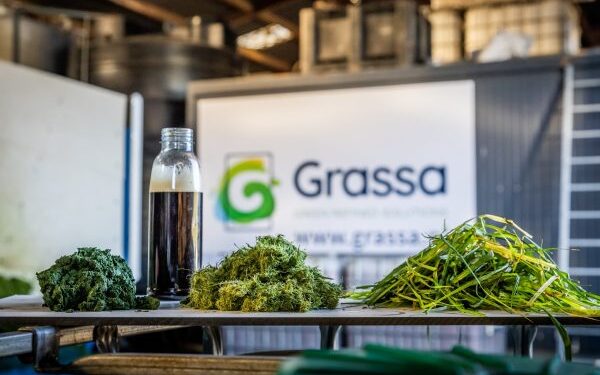“Grass protein has massive potential,” says Rieks Smook, director of Grassa. “Grass yields 2.5 times as much protein per hectare as soy. Grass supplies are readily available. Grass protein is a high-quality, local and scalable alternative to soy. When compared to other protein sources, it provides a huge reduction in the carbon footprint.”
Less nitrogen
“A cow converts only 30 percent of the grass protein into milk and meat. Seventy percent is converted into manure. Grassa removes some of the excess proteins from the grass beforehand. The residual product, processed grass, is eaten by the cow. In this way, the protein in grass is optimally utilized,” continues Smook.
In addition to extracting 50% more protein from the same hectare of land, the nitrogen problem is also tackled at the source. The import of soy is replaced by grass protein and because of less protein in the processed grass, the cows emit less nitrogen (ammonia).
Protein transition
The term protein transition refers to the shift from the consumption of animal proteins to (more) vegetable and alternative proteins. “As a pioneer and innovator in the meat substitute market, we are always looking for interesting protein sources that can contribute to the protein transition,” says Henk Schouten, owner of Schouten Europe.
“We are very interested in protein from grass,” continues Schouten. “It is our ambition to use sustainable and local ingredients in our products. The partnership with Grassa is therefore a great step for our company. In the coming years, our product developers will investigate the applicability of grass protein in meat substitutes together with Grassa.”
Rieks Smook of Grassa: “We already collaborate within the animal feed sector and are very pleased that we have found an exclusive partner in Schouten Europe for the application of grass protein in human nutrition.”
National protein strategy
In order to meet the need for vegetable protein, the European Union wants to become less dependent on the import of protein-rich crops such as soy and become more self-sufficient. In 2018, the European Commission called on the member states to develop a national protein strategy. Following the European Commission’s protein report, the Dutch government presented the National Protein Strategy for the Netherlands in 2020.
Link with human consumption
The National Protein Strategy aims to increase self-sufficiency in new and plant-based proteins over the next 5 to 10 years, in a sustainable way that contributes to the health of humans, animals and the natural environment. Grassa’s process is mentioned in the National Protein Strategy and seen as a promising innovation to produce local plant-based protein. The collaboration between Grassa and Schouten Europe is in line with this and provides a direct link with the human consumption of grass protein.
Novel Food
Novel foods or ingredients are checked for safety by the European Food Safety Authority (EFSA) and only enter the market once they have been approved. Grass protein also falls under these so-called Novel Foods. Grassa and Schouten expect approval for human consumption of grass proteins. This is why the two companies are jointly investing in research and product development now.



